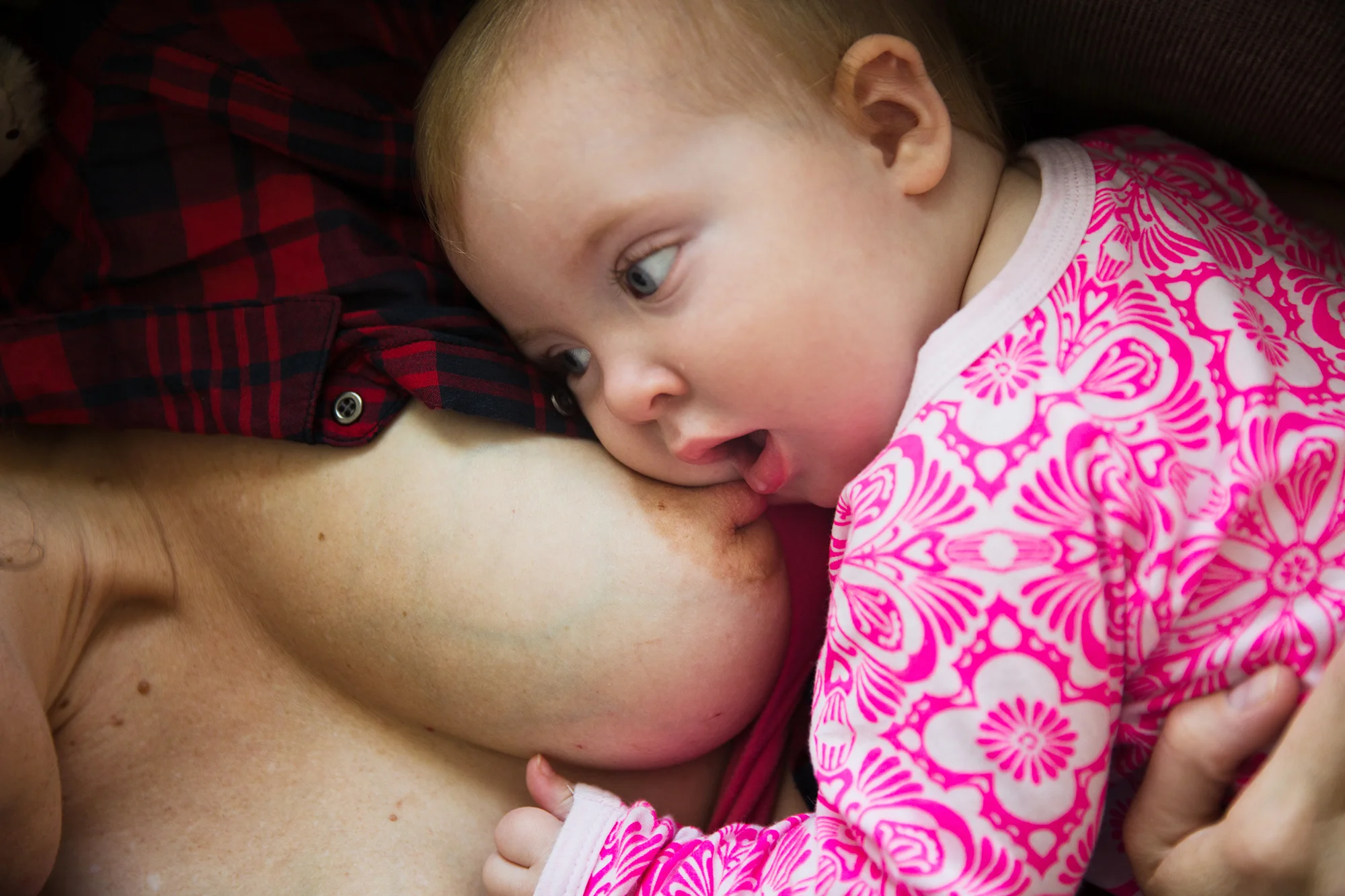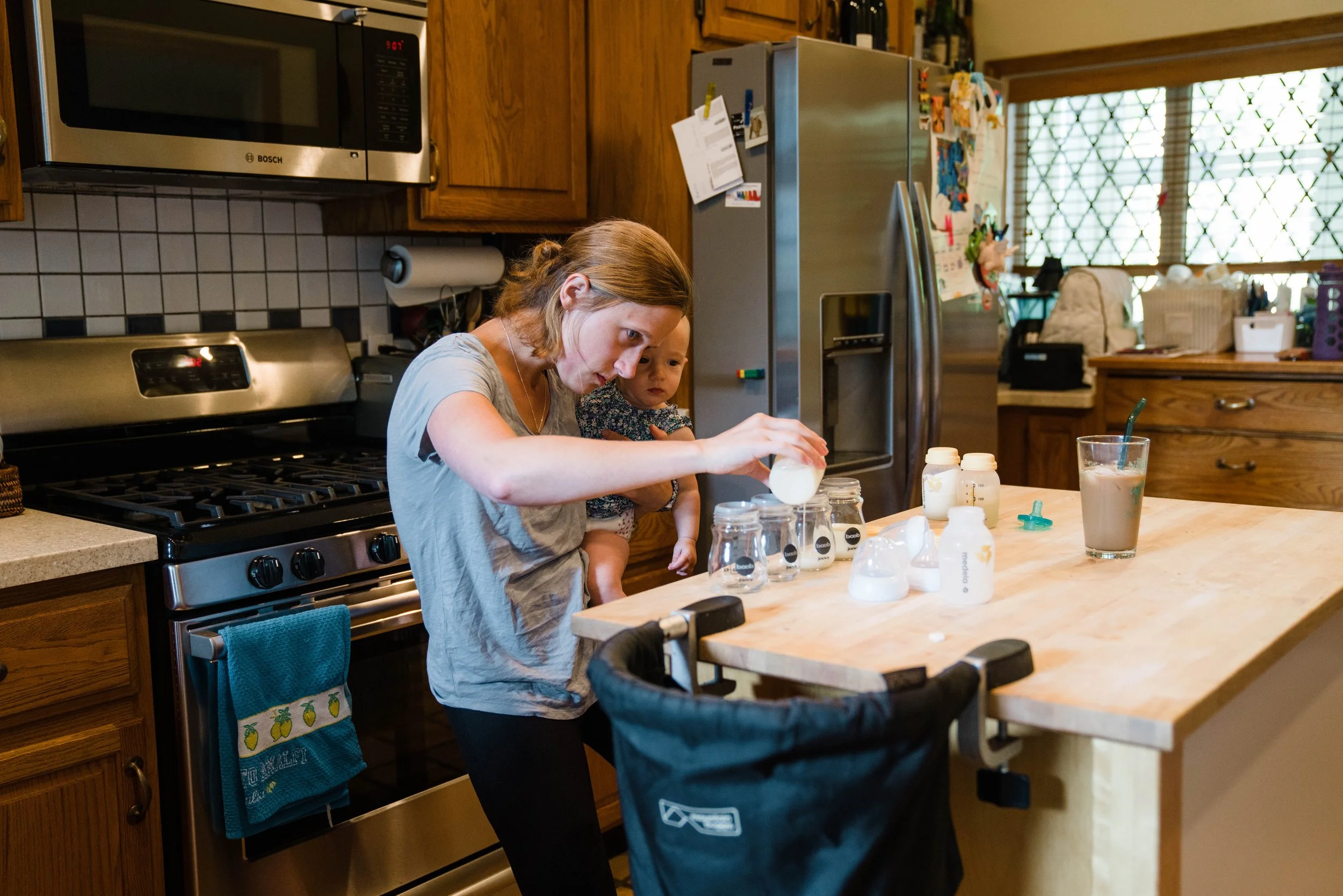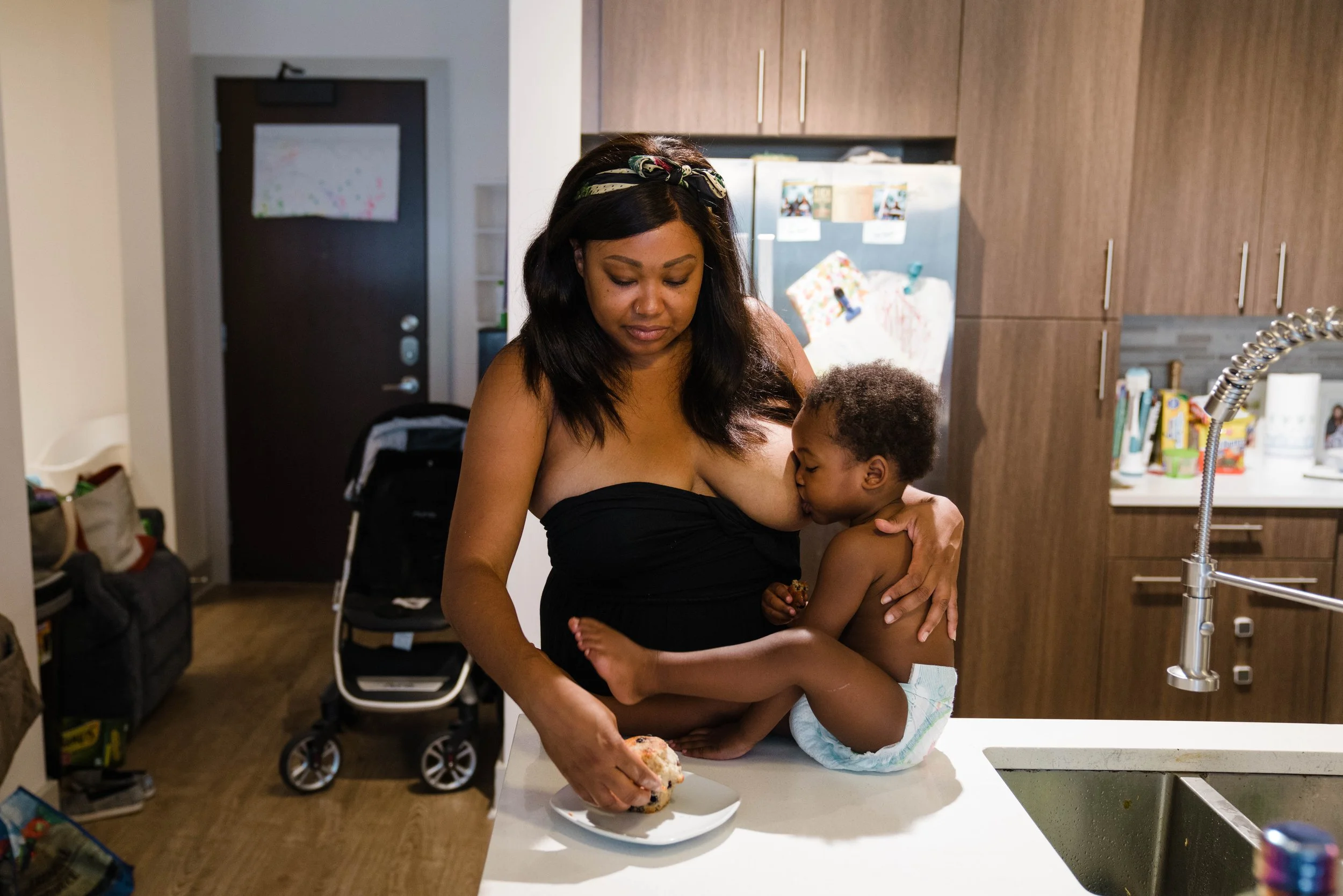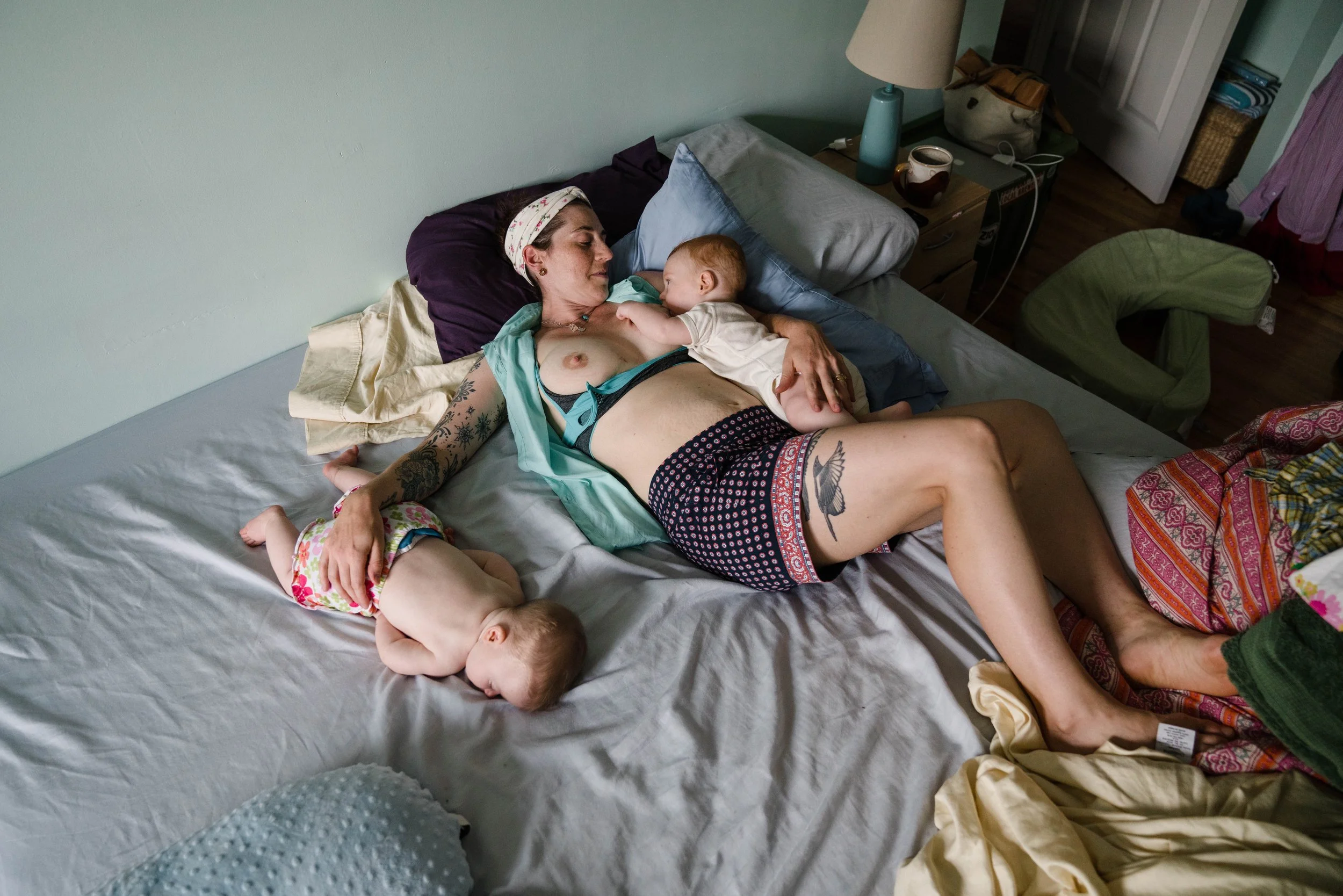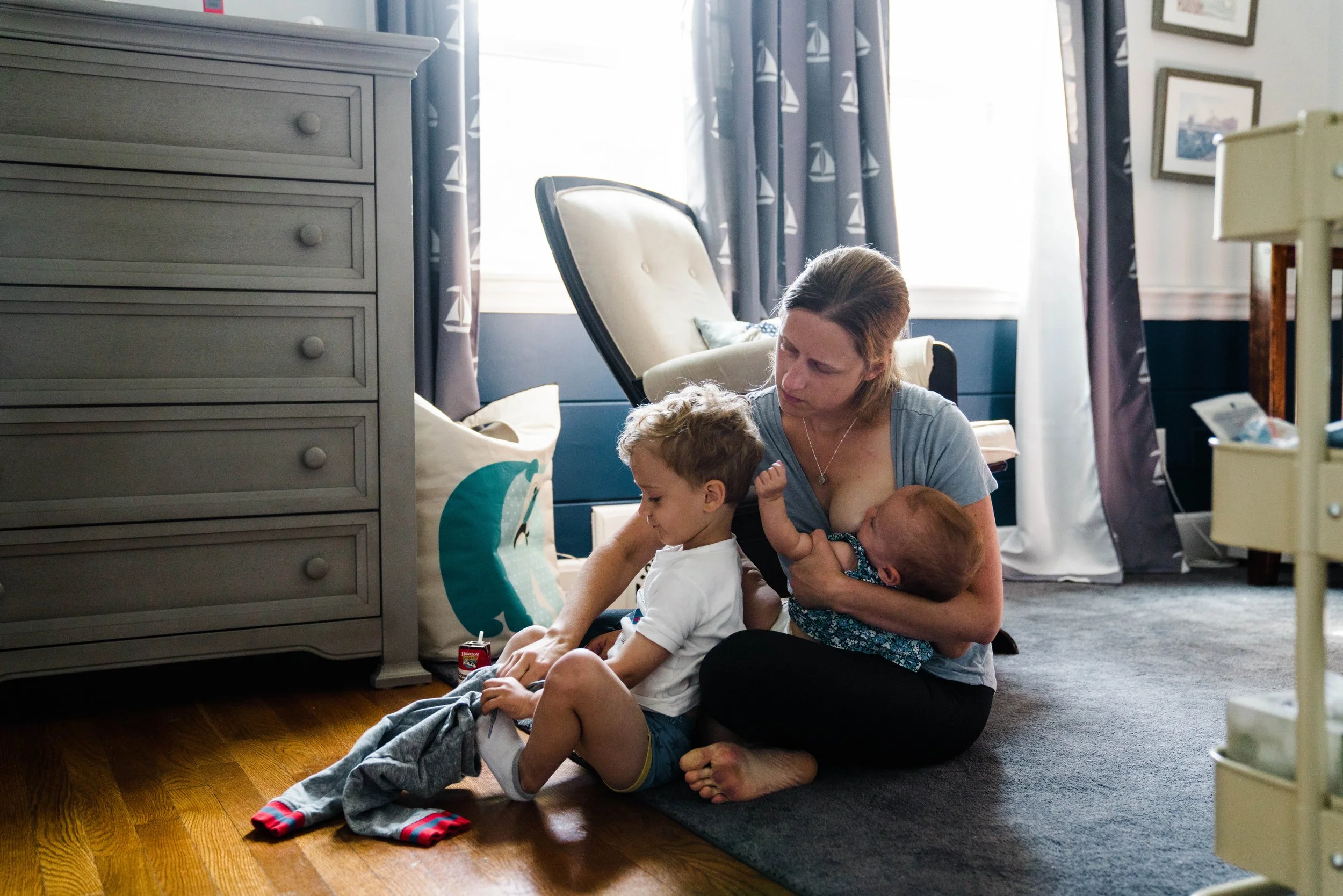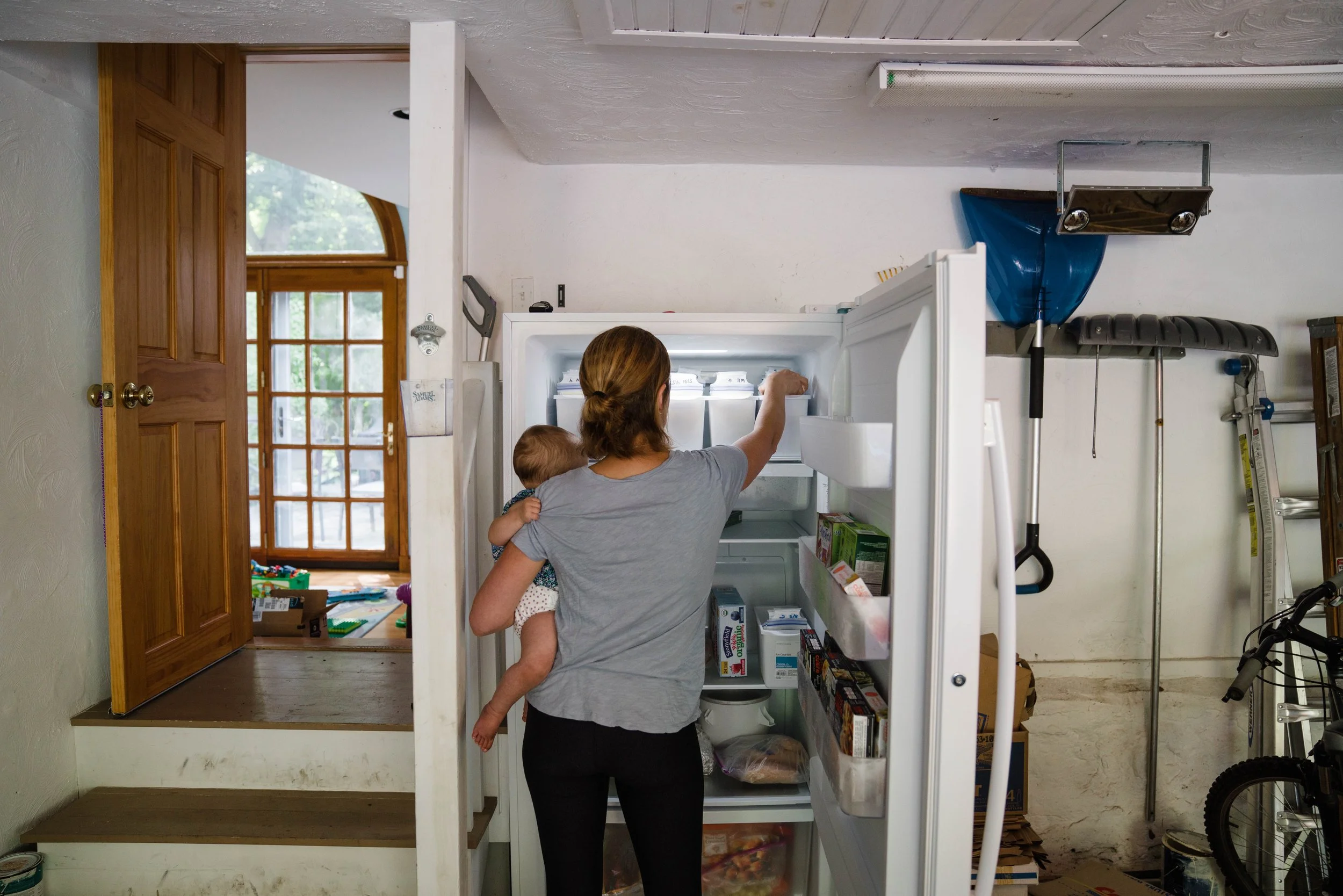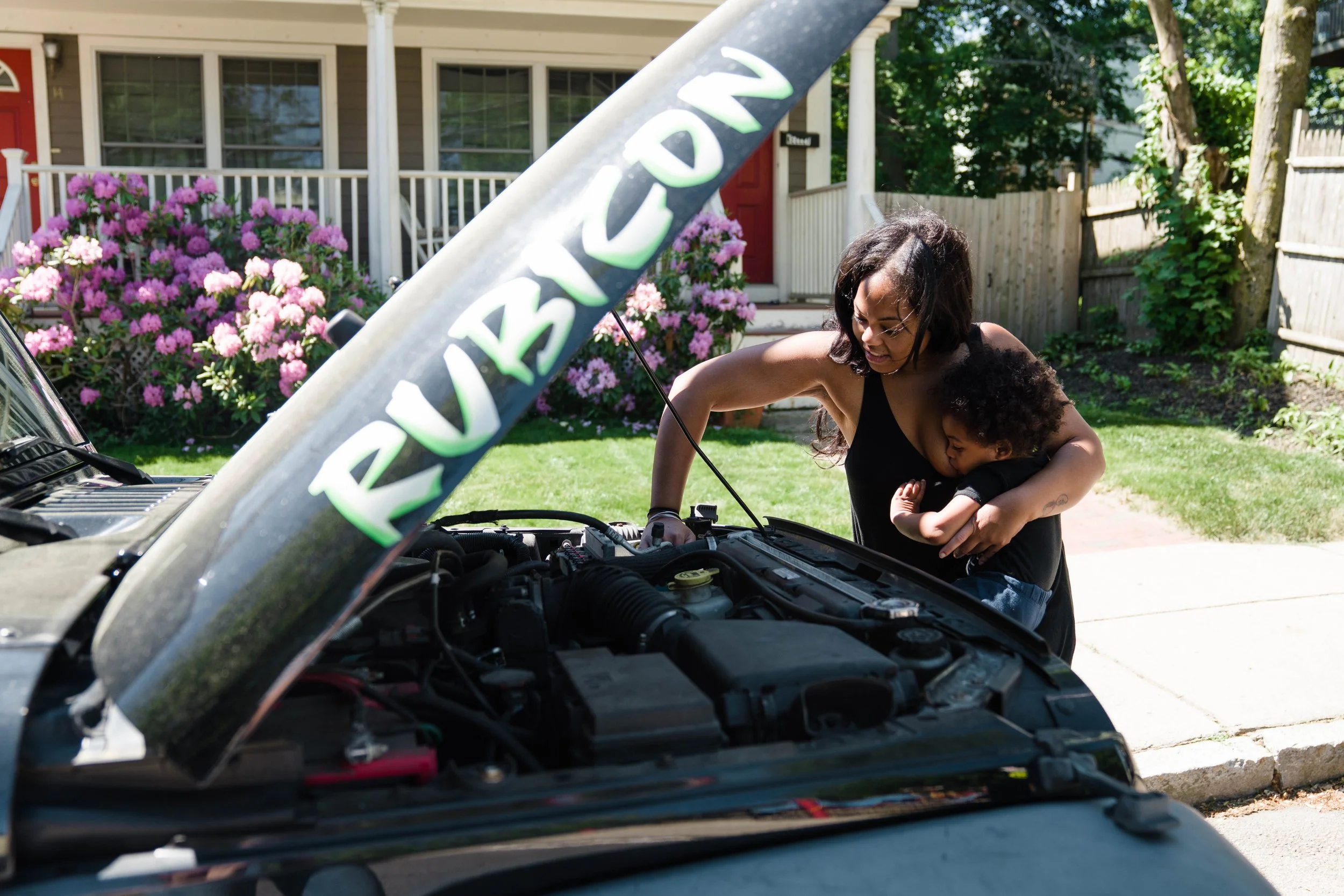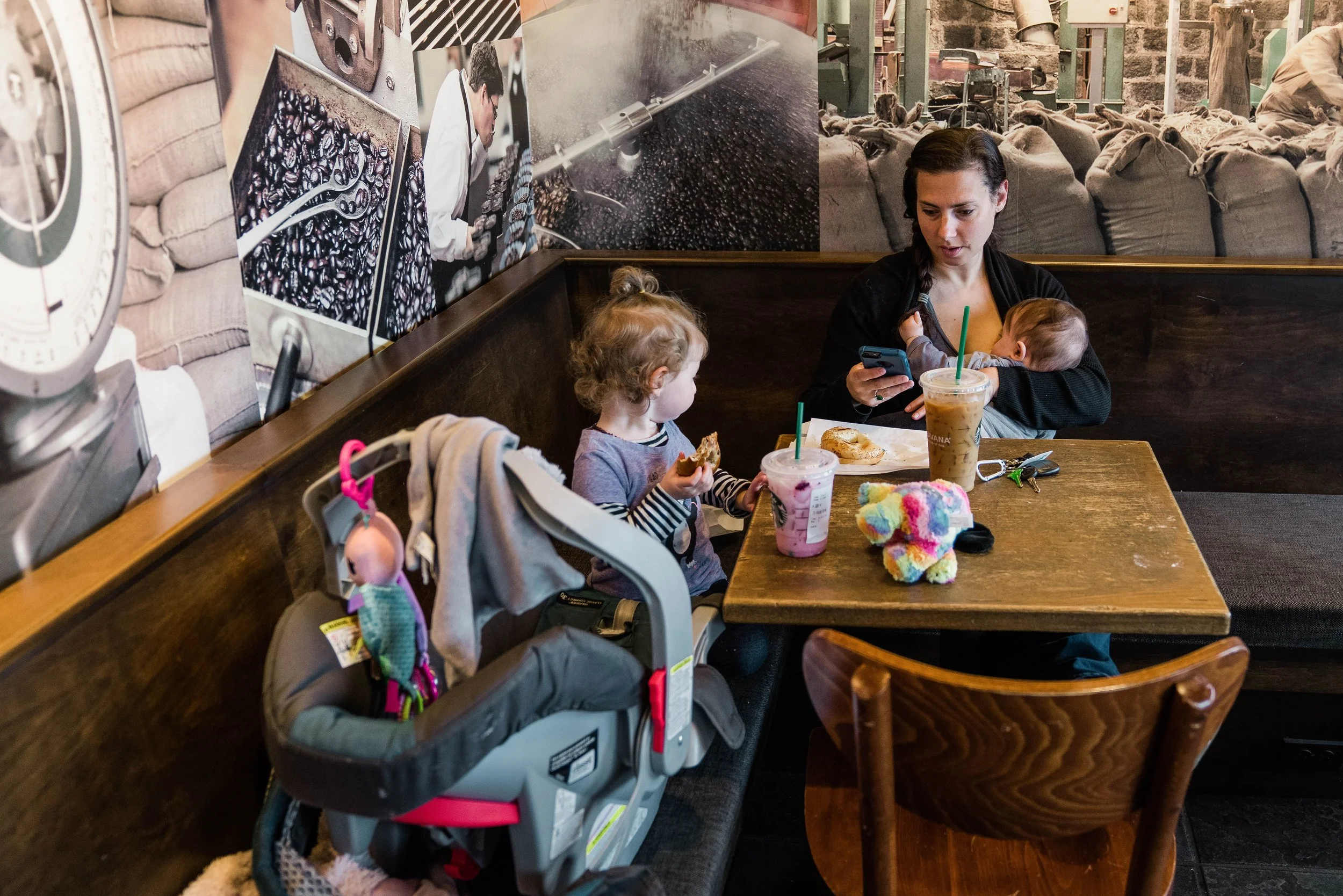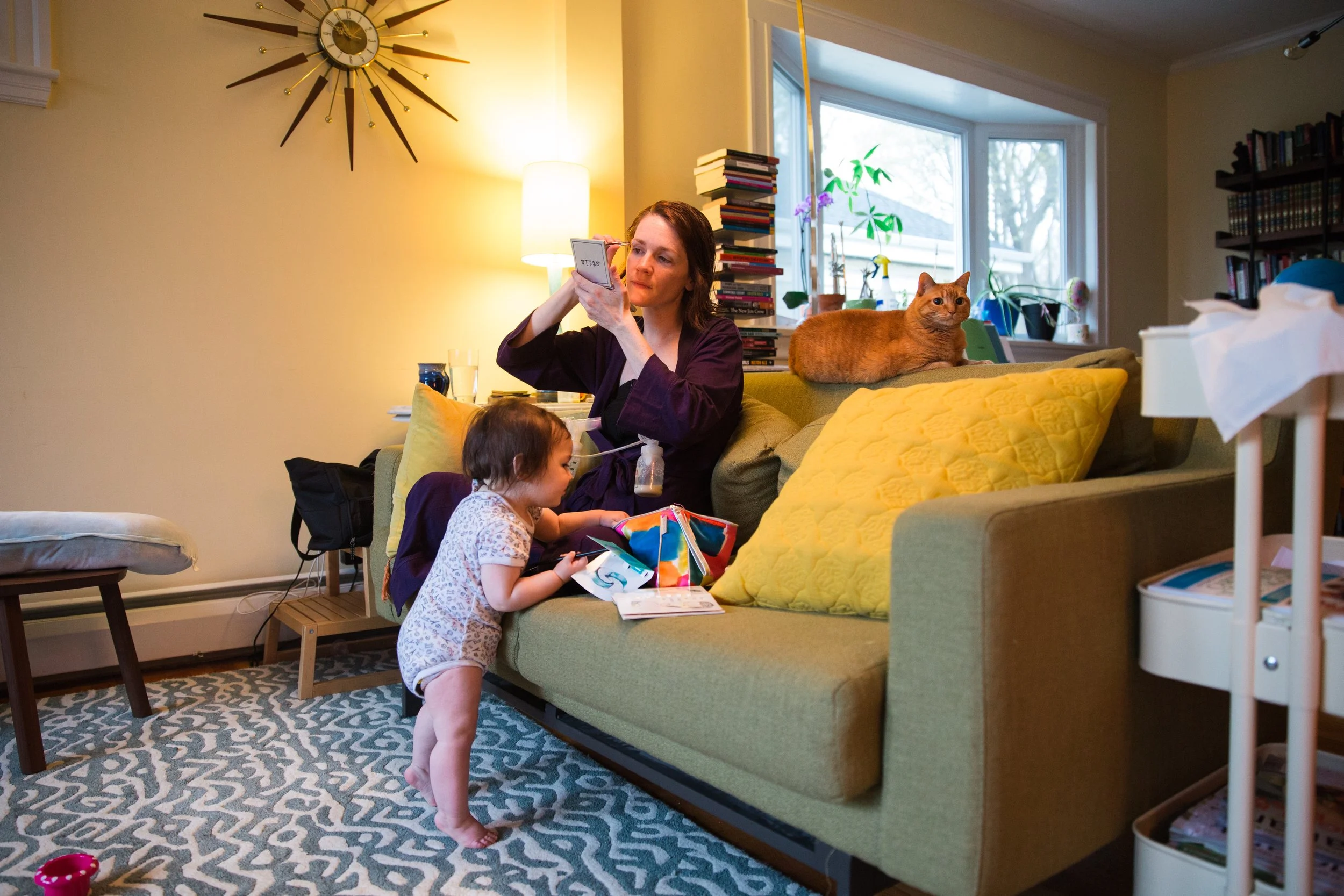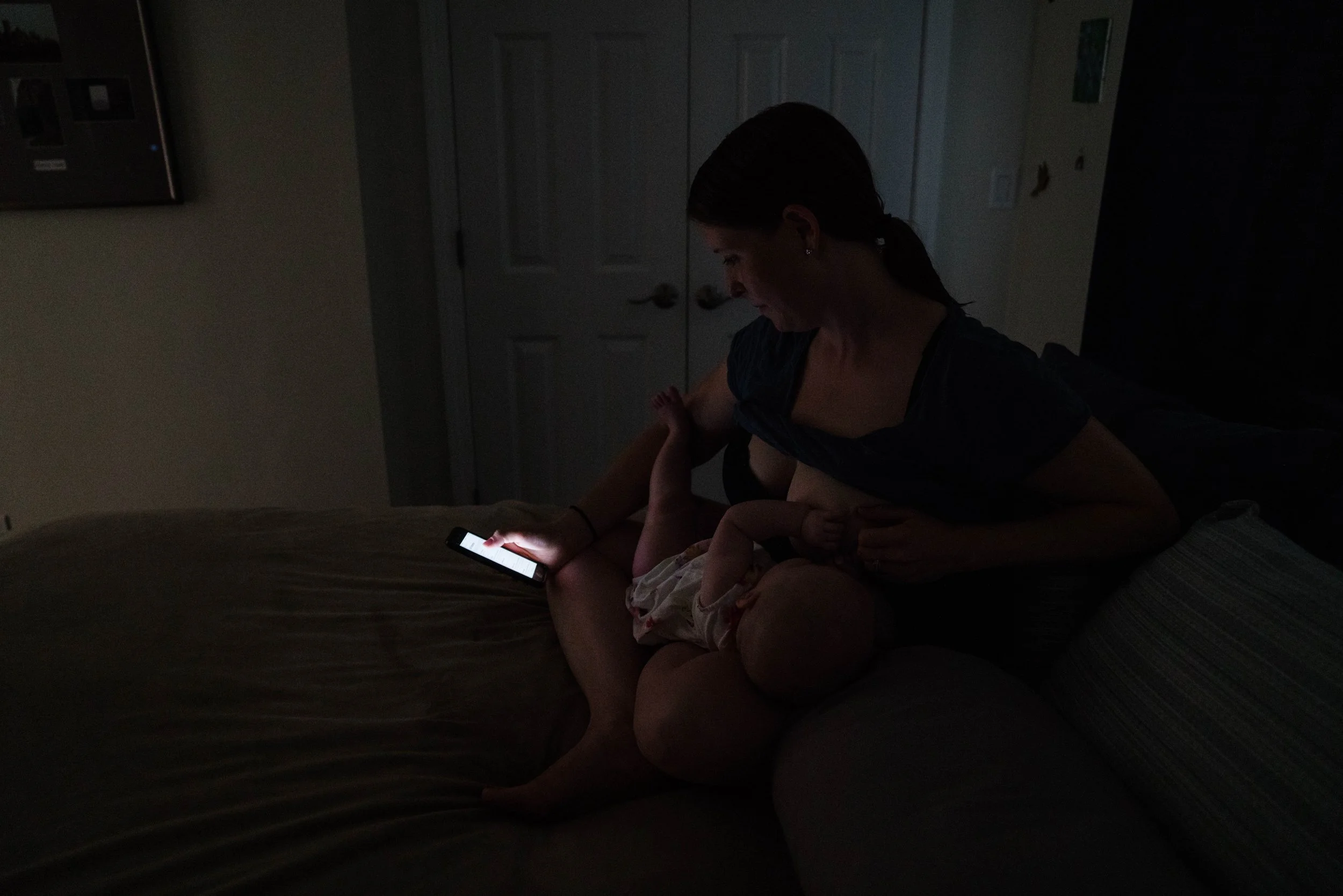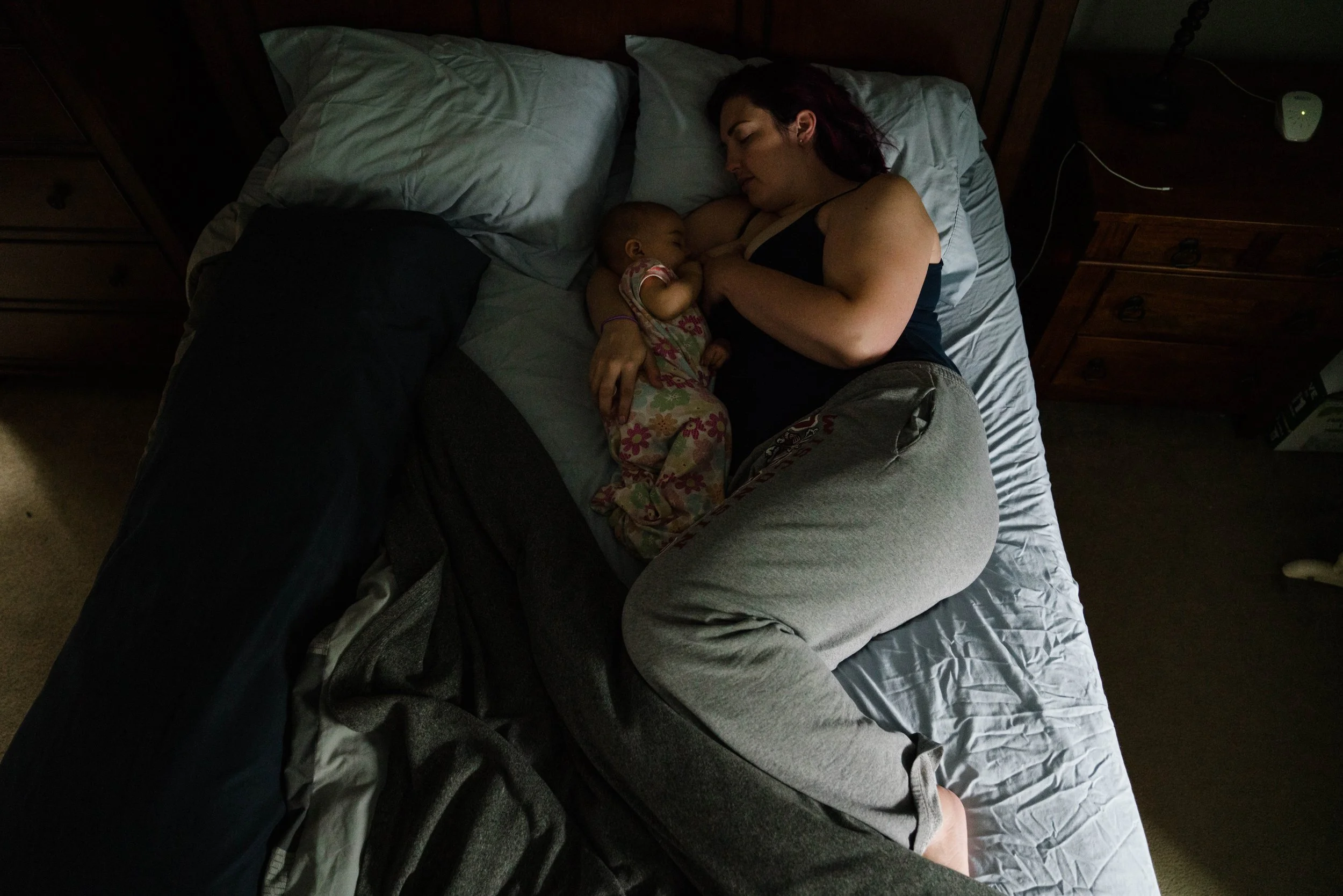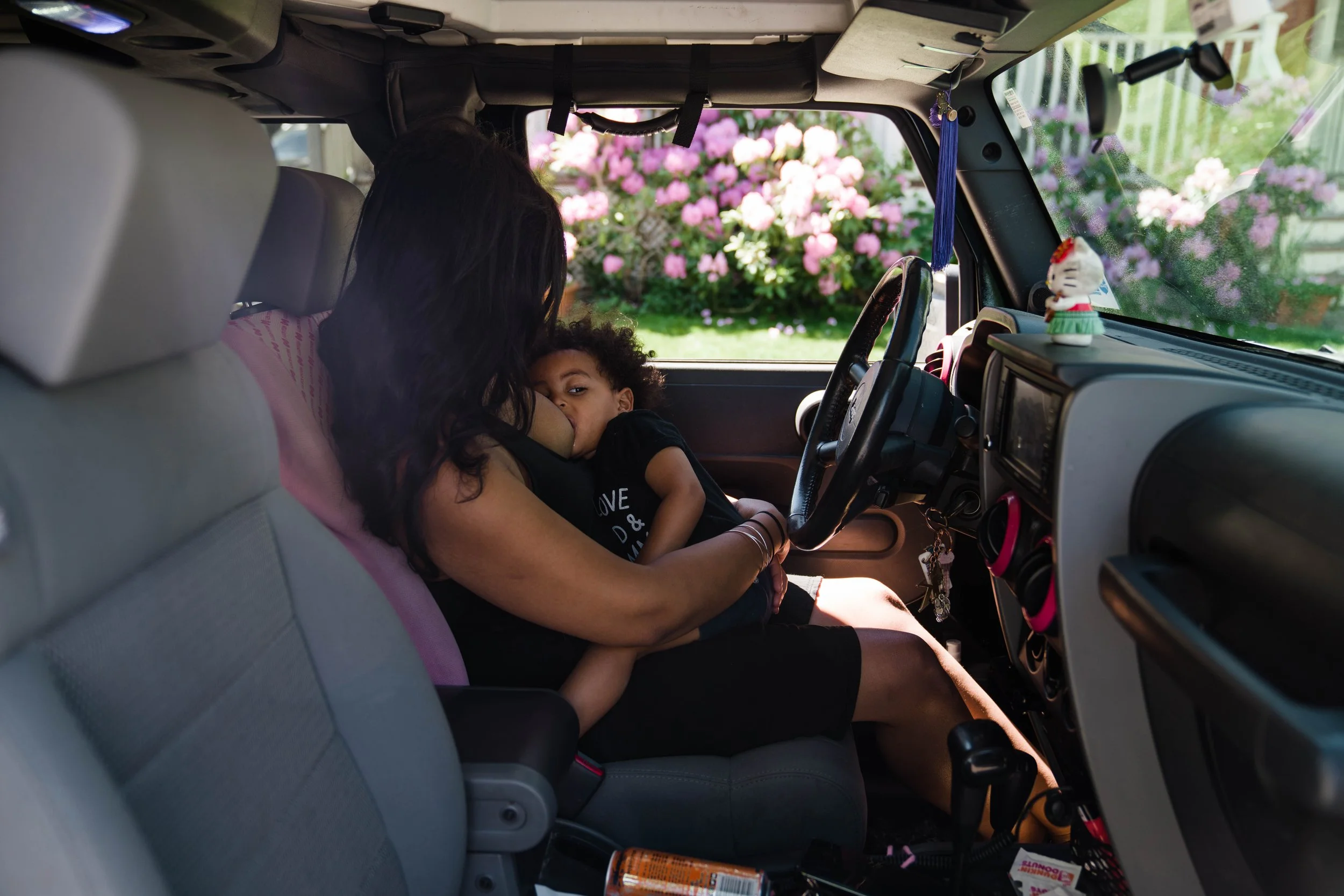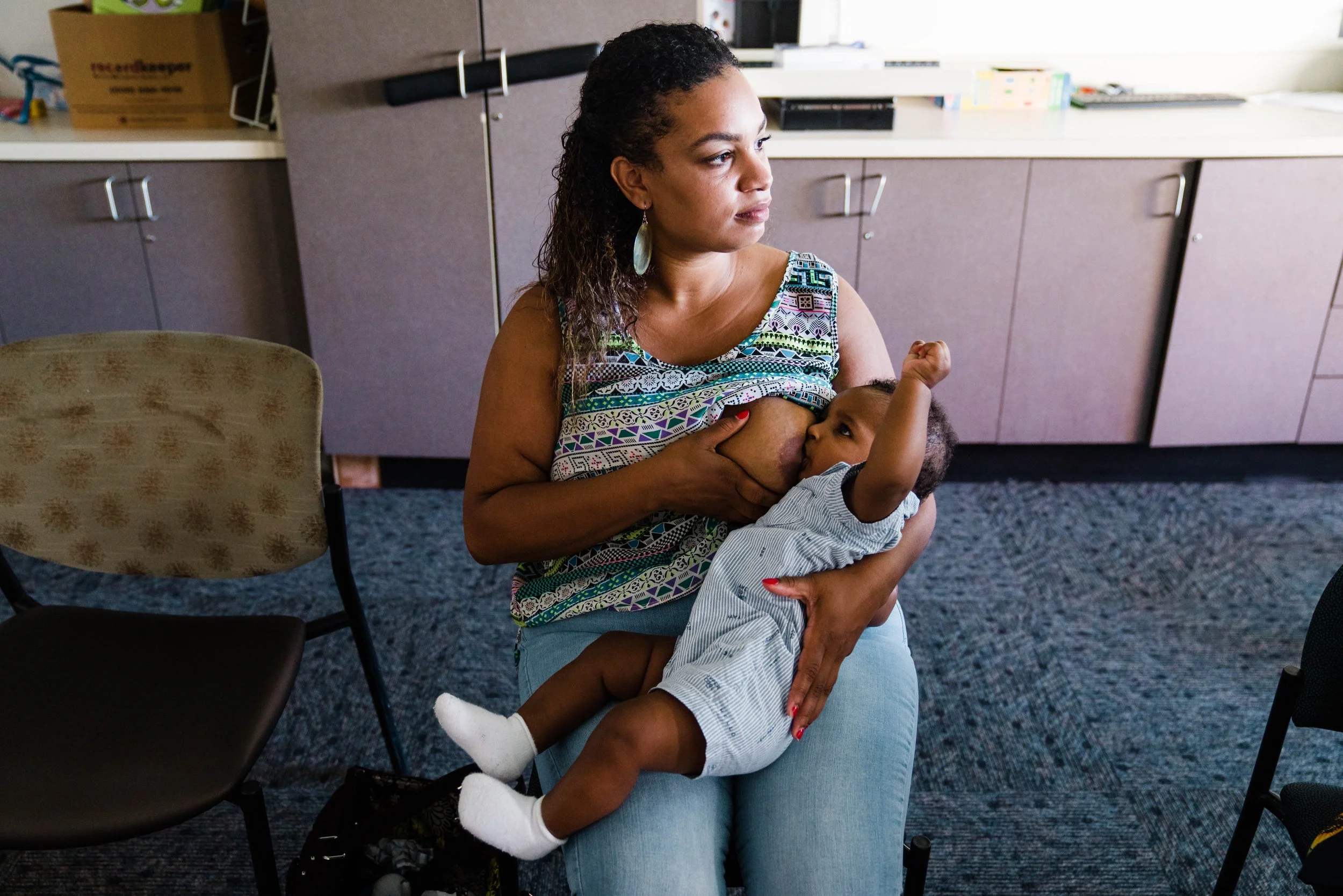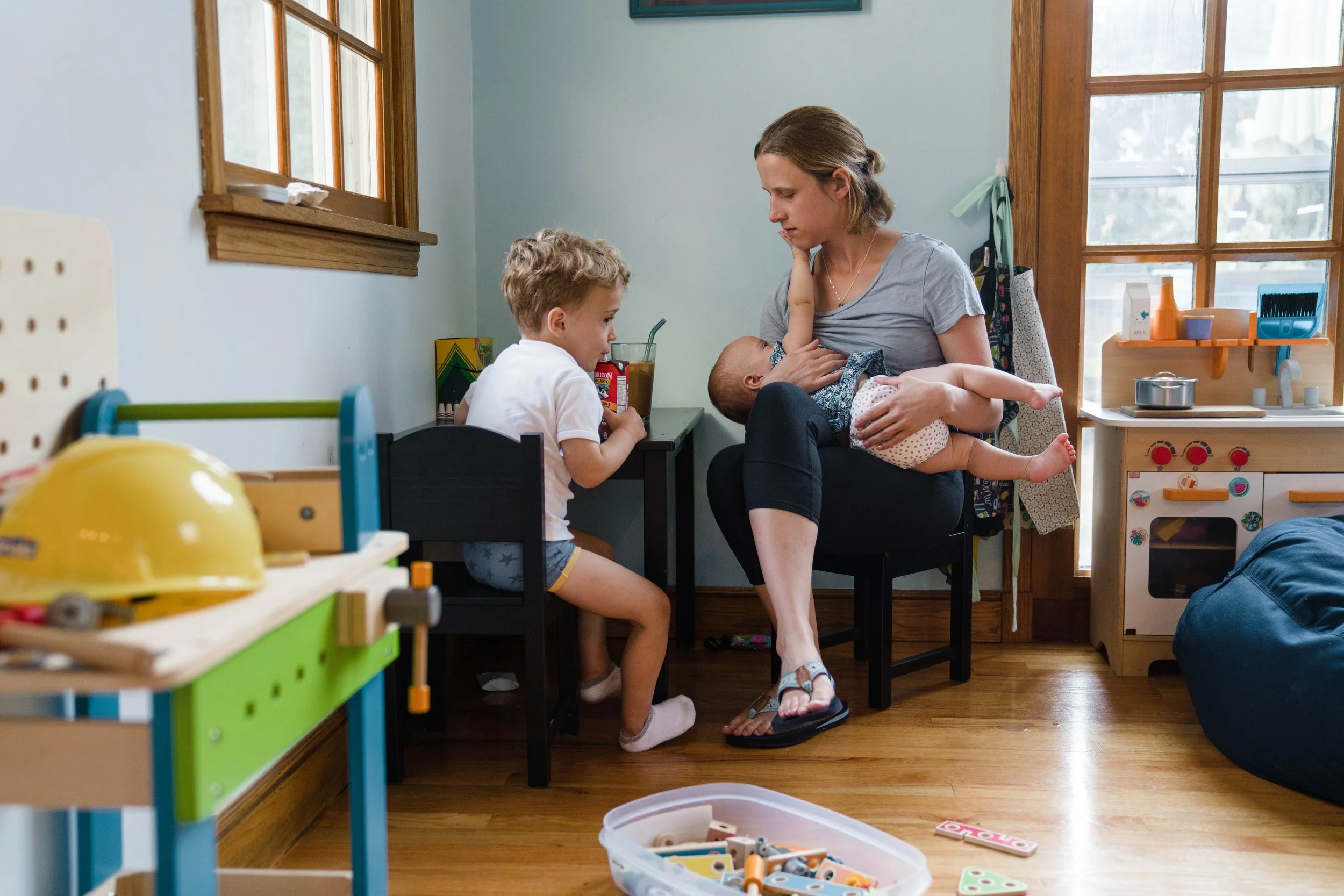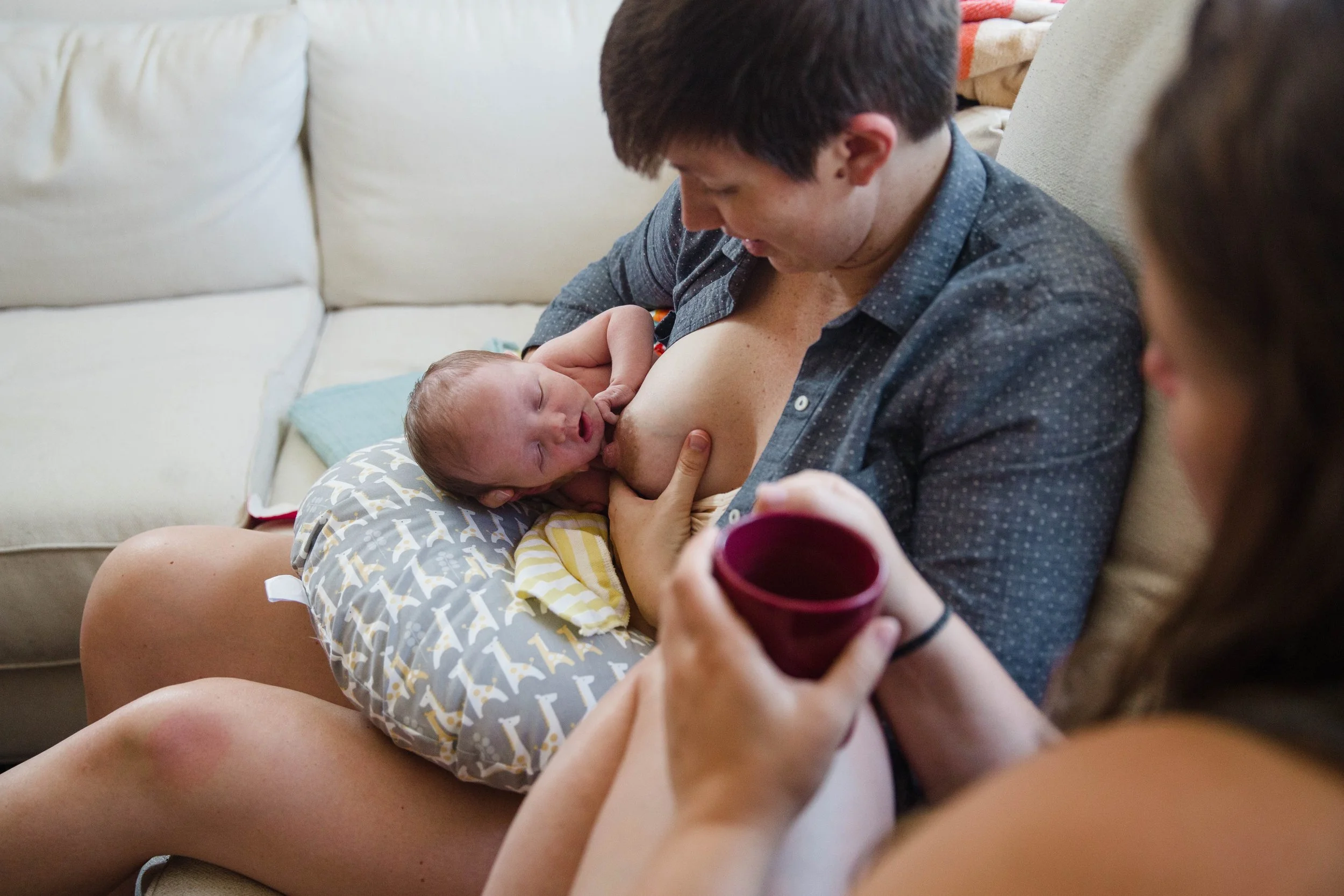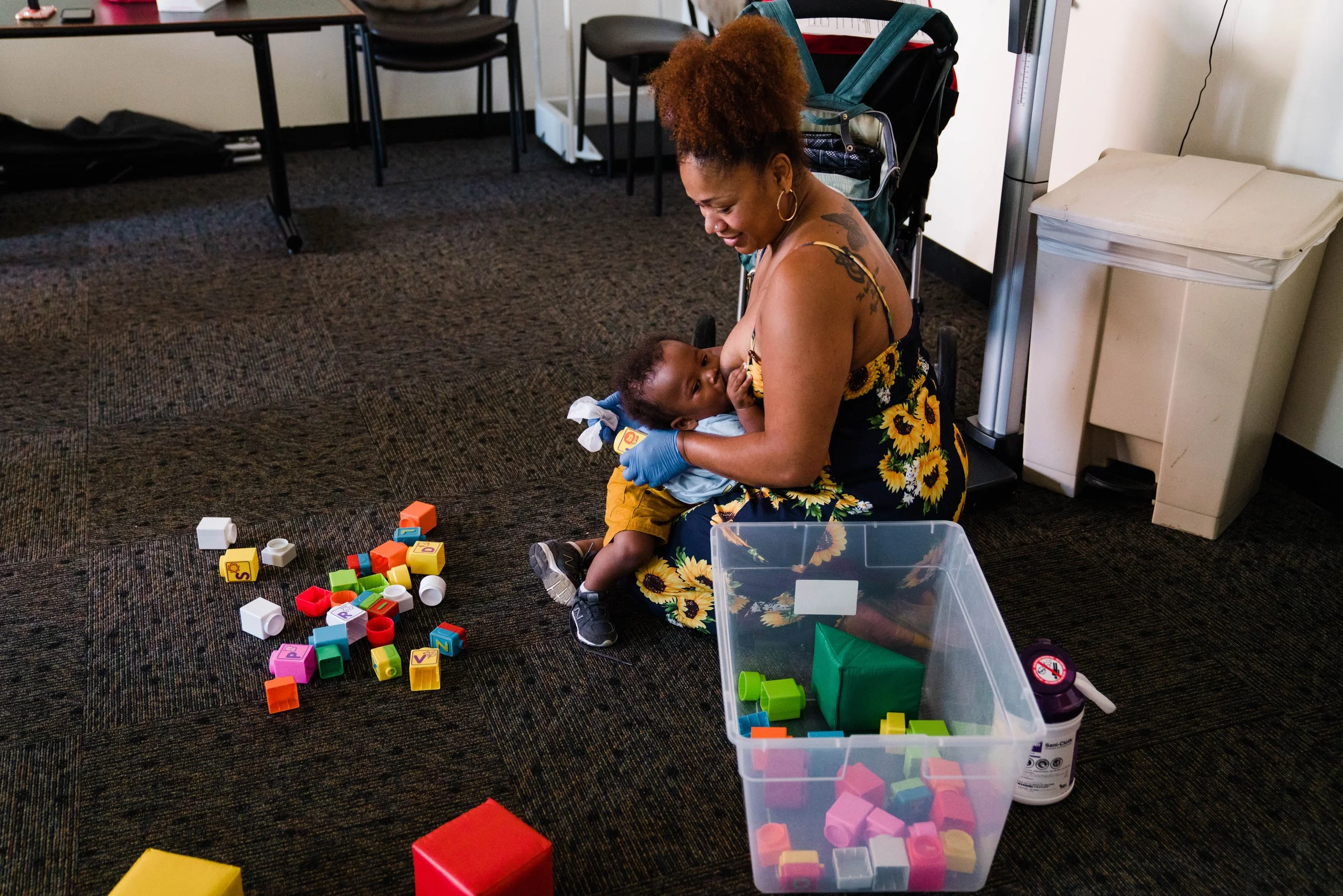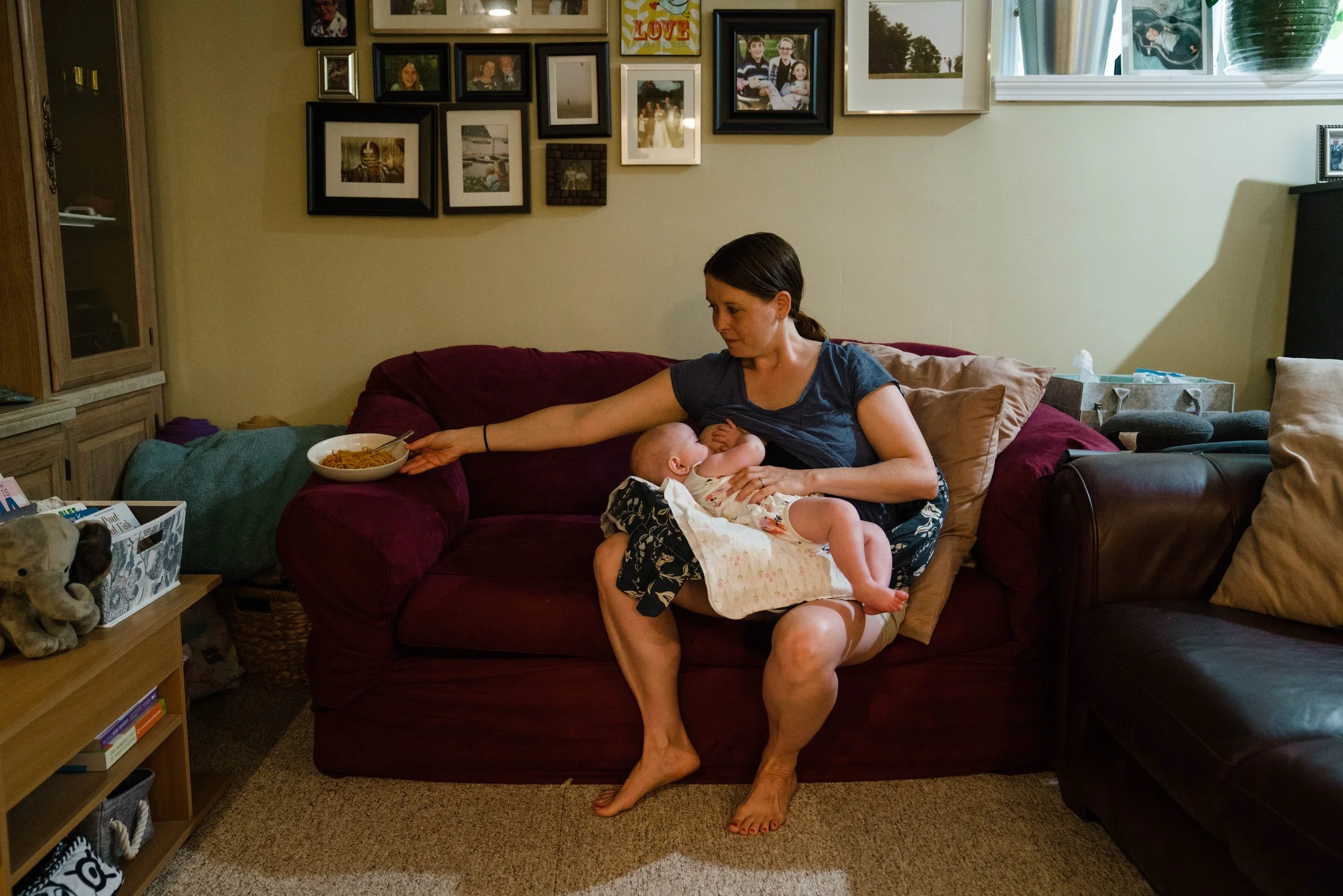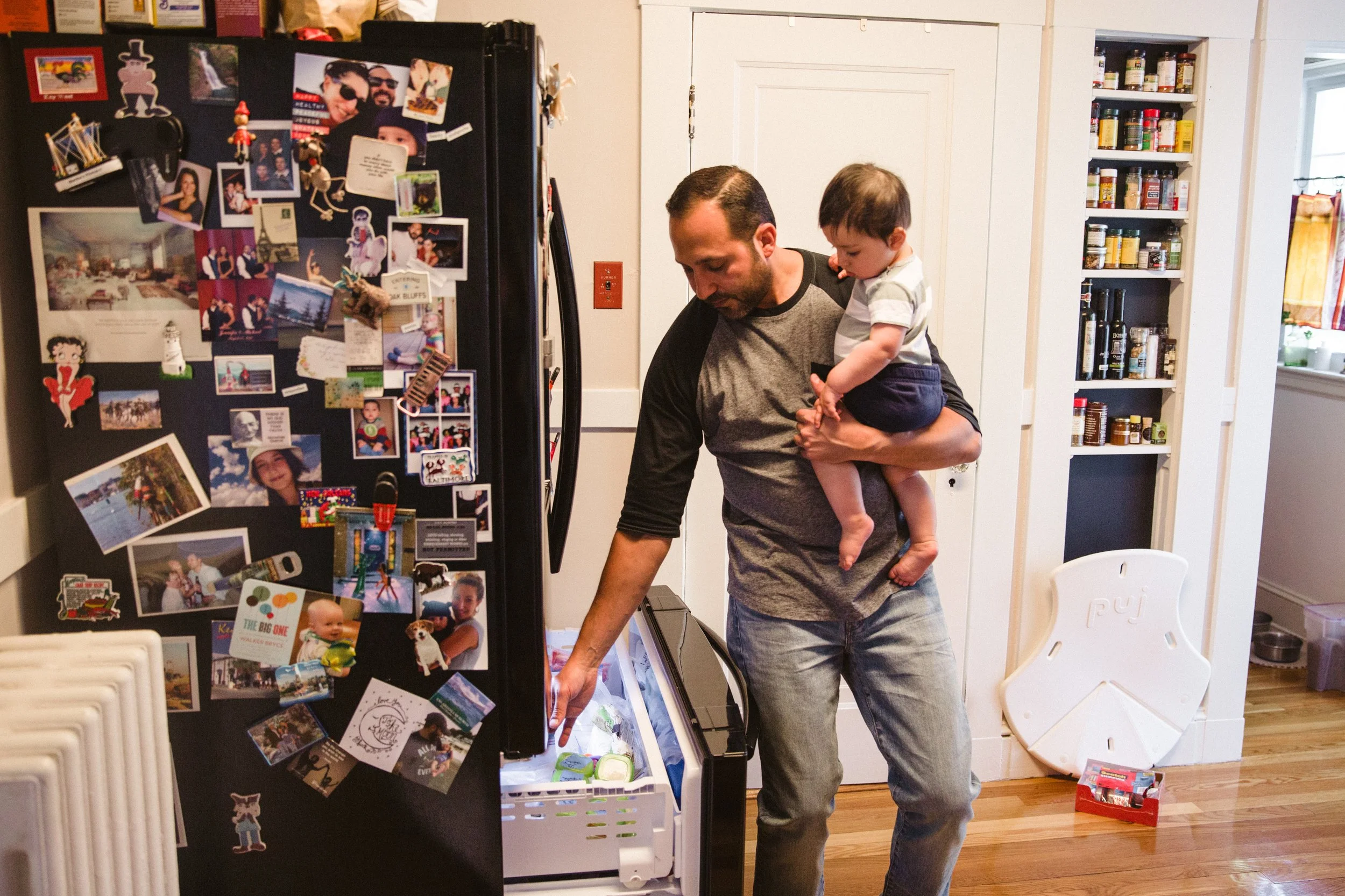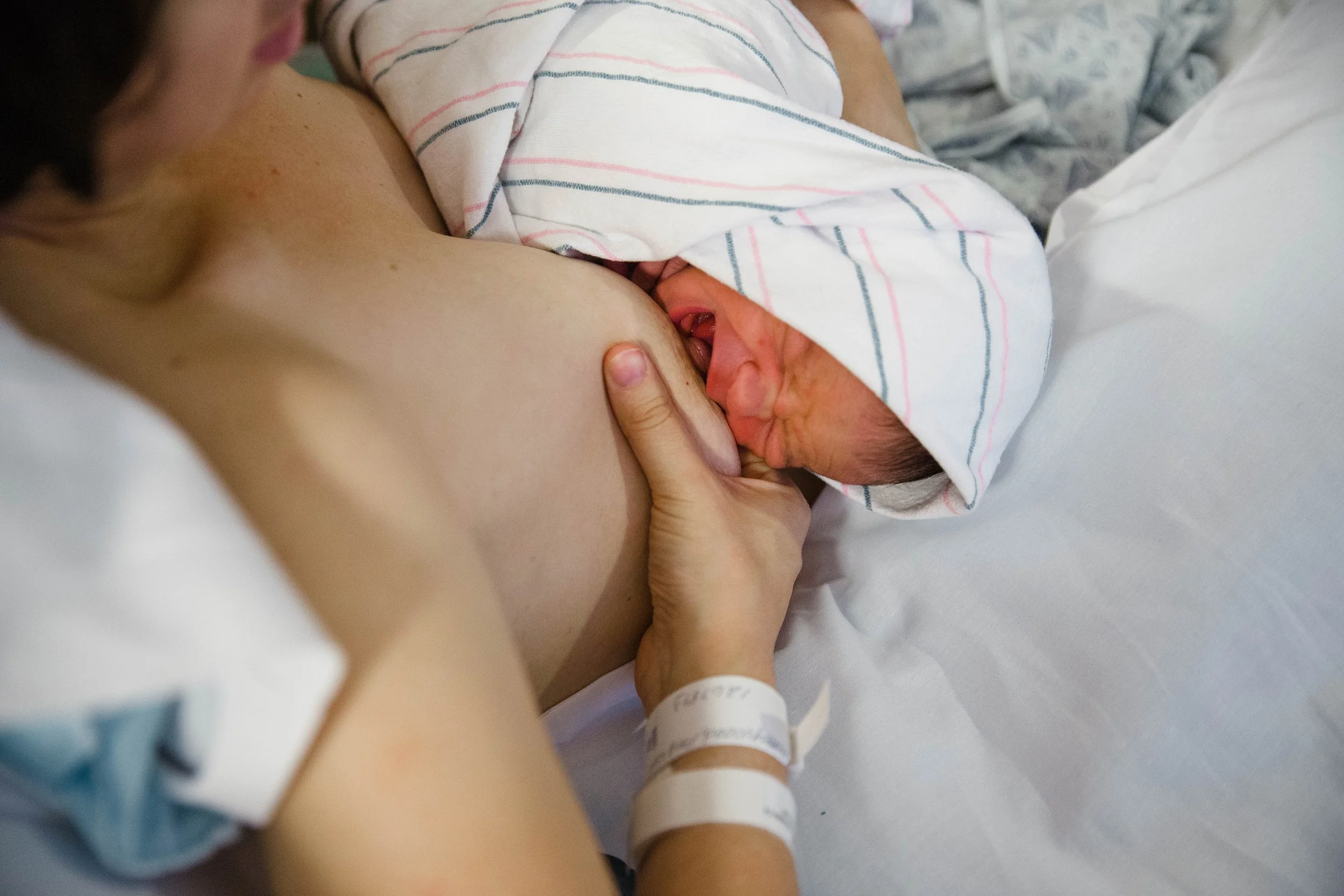Latched On: The Realities of Breastfeeding
With my 10-month-old son strapped onto my front and camera in hand, I squeezed into Monica’s SUV. I began to document her feeding her 16-month-old daughter following the regular afternoon pickup of her older daughter. Marlin was snug in her lap nursing, while three-year-old Simona climbed to the front of the car to see what other entertainment she could find. Kids songs played on the speakers and the cracked windows let just enough breeze in. They were parked outside the Arnold Arboretum, in Boston, hoping to take advantage of the spring weather.
Monica, Marlin & Simona
"As I sit here multi tasking at afternoon pick up with the older sister occupied and Marlin happily suckling in my lap I realize that breastfeeding isn't always "beautiful"in the aesthetic sense. What I love about it is the raw immediacy. A procrastinator and unplanner by nature, breastfeeding fits my lifestyle perfectly. Nothing to remember, nothing to clean just my ladies and my baby. Breastfeeding provides me with that sort of freedom and also empowerment. I don't think it was by mistake that God designed our bodies to be sufficient. When all is stripped away I am still enough for my babies and that is powerful. That feeling of empowerment is what continues to propel me through the unknowns & trials of parenthood with confidence.”
Breastfeeding is a choice and commitment. With its many rewards, comes challenges and sacrifices. Physical pain, being constantly on call and the unbalanced care-giving between you and your partner – to name a few. Battling outside criticism and judgment is often another hurdle families have to face. Often, mothers feel pressured from their own families to stop breastfeeding once their baby gets to a certain age. Partners have suggested that it’s inappropriate to nurse in certain public settings. One mother had laughing teenage boys photograph her while breastfeeding on public transportation.
According to the National Center for Chronic Disease Prevention and Health Promotion in the United States, 81.1 per cent of babies are breastfed and 51.8 per cent are done so to the age of six months. Of this 51.8 per cent, roughly one-quarter are exclusively breastfed – meaning no formula was used. Throughout the rest of the world, an average of 43 per cent of babies are exclusively breasted until six months of age.
This past spring, the United States opposed a resolution to encourage breastfeeding in Geneva for the United Nations-affiliated World Health Assembly – a stark contrast to the Obama administration, which supported the World Health Organization’s long-standing policy of encouraging breastfeeding. A 2013 study in The Lancet found that universal breastfeeding would prevent 800,000 child deaths a year globally, save US $300-billion in health-care costs and improve economic outcomes for those raised on breast milk.
After personally navigating uncomfortable and challenging situations, the need to share the realities of breastfeeding led me to begin this project. Usually worn in a wrap – and often nursing – my son, and later, daughter, and I ventured into over 50 Boston families’ homes and lives to document their typical breastfeeding routines. Hearing from the various caregivers reaffirmed how crucial sharing their experiences are. Knowing the realities of breastfeeding empowers families and normalizes this very natural and beneficial part of life.
A small selection of photographs and quotes, from the larger body of work, are included here:
Suzie & Sam
"Dear Sam, I never thought we would "do mimi" (nurse) for 3.5 years!!! But it is fading away, and I know it will soon come to an end... Since you nursed so long, you might later still remember mimi, perhaps a little, and I hope it is a good memory.”
P & E
“Before I had my daughter I had three miscarriages. I felt broken... It is wild how differently I look at my body now. The lack of trust I had in it years ago has been transformed. I now can’t help but view my body as a powerful life source.“
Michele & Riley
"My milk took 5 days to come in. I never read it could take that long. No one told me that waiting 3-5 days was typical. I needed a nipple shield for the first 6 weeks, because my nipples were too flat. I couldn’t figure out how to hold the shield in place, hold down Riley’s arms from swatting at me and somewhow shove his head and widen his mouth onto my nipple when I was alone. Our breastfeeding journey is now 7 months strong and I have no intention of weaning. Even though he now gets distracted, pinches and scratches, breastfeeding has been the most bonding and empowering part of motherhood for me."
Caitlin & Eloise
"I think we do women a great disservice by acting like nursing should be simple, that it will come naturally and easily, that their bodies and their babies will just know what to do. Because so often it is anything but easy, and by not being up front about that, we set women up to feel disappointed in themselves if they struggle, to believe that they fail their children if they don’t love every second.”
Anna-Maria, Iggy & Niko
Rachel & child
“We have been lucky. For the most part, nursing has come easy to us; and I hope to continue until he self-weans. We’ve had our challenges, but nothing that made breastfeeding more stressful than rewarding. Some days I yearn to have my body to myself again, to not have little fingers picking my nose or sticky hands pulling my hair; but every day he continues to nurse is a day I can hold onto my baby a little bit longer. I know I’ll cry when he decides he’s all done. I almost cry just thinking about it.”
Alex & Hunter
Libi & Children
“What does nursing mean to me? It means I can nourish my baby. I can comfort him when nothing else works, I can give him an extra boost when he’s sick. Mainly, it means that multiple times a day, I am forced to stop, even if for a split second, and live in the present. Breathe in the moment. Connect with my son in a world in which others command my attention, the clock ticks too fast, the images are fleeting and the growth is too fast. In that split second, I have something forcing me to be present and grateful for the responsibility that I’ve been given with these beautiful children of mine.”
Jodi, Bryn & Harper
"Right now I am teaching breastfeeding classes, seeing private lactation clients, training women to become lactation educators and actually breastfeeding a baby… so needless to say my life is boobs and milk."
Molly & Isla
"When my son was a baby I would walk over to his day care and nurse him. I still pumped every morning and on other rare occasions, but it was such an irritation to me. Nursing Isla during the workday was never an option. Providing expressed milk for her is a way I can be with her when we are physically apart. I’m able to slow down and think about her when I pump at work. As I prepare to pump in the mornings I tell her “I’m going to take some milk out for you for later!” This morning routine gives me the chance to be still and be with both of my children. This time is priceless to me."
Michele & Riley
Mellissa & August
"My favorite part of breastfeeding our son is the look of complete calm on his face. Watching the stress melt away as he nurses makes me feel like 'we got this'."
Melissa & Augustis
Emi & Twins
“Being a breastfeeding twin mom is kind of like having a secret superpower. When I’m at work or out in the city without my twins, I often think how people passing me have no idea that inside my body I’m currently making food for two people. It’s a lot of work and I often feel like I can hardly keep up with eating, drinking, and pumping enough, but I move through the world with a special kind of confidence and pride now because after all, I’m a very important person. Not that I wasn’t important before, but now no matter what else I’m doing now I’m also either feeding a baby or making milk for them!”
Molly & Children
"I have three children, very close in age, that still nurse. I would be the mom that would be wearing a sleeping baby on the front, sitting having a coffee, while the two toddlers were nursing out of each side of the carrier. My husband and I traveled quite a bit before we had children and were lucky to witness breastfeeding in public as a very normal part of everyday life. We spent 60 hours on a bus from Laos to Vietnam with a woman traveling alone with a baby and a toddler. They would go between playing with a couple of toys to checking in with their mom through nursing. They were happy as can be for a 60 hour bus ride. It amazes me that we don’t see this in our culture since full term breastfeeding isn’t the norm."
Rachel, Theo & Beatrice
Tess, Wyatt & Ceia
Brittney & Children
"Four years ago, I struggled to nurse my preemie twins and breastfeeding was stressful, painful, and only partially successful. My third baby was born full term and nursing has been blissfully easy this time around. Having such different experiences has given me a lot of perspective. I have so much empathy for moms who have difficulty breastfeeding and I don’t take nursing for granted because I know it’s not always as effortless as it looks. I give thanks every time I feed him and I’m savoring every moment of nursing my last baby!"
Kelly & Natalie
"While pregnant, I had these idyllic visions of working-from-home with my baby: nursing her comfortably in a rocking chair, taking conference calls at my desk while she napped... Then she was born and reality hit! My daughter always seems to wake up and needs to nurse right in the middle of a meeting. My quiet workspace was moved to the middle of the living room, our version of ground control, with toys thrown everywhere and me cradling her in one arm while I check emails. It isn’t pretty, it isn’t perfect – but we make it work."
Sara
Terri & Child
“A love-hate relationship. I love knowing I can nourish and grow a human being with just the milk produced by my breasts. It’s amazing. I can grow a human both within me and outside of me. The bond and connection is beautiful. BUT I hate that I’m bound by this little human. I’ve lost a sense of my own time and pace. When he’s hungry, I drop everything I’m doing and unwrap my cumbersome layers to get to the boob. I no longer wear the clothes I love and made me feel beautiful. And yet I feel lucky that breastfeeding hasn’t been a huge challenge for us. So I feel guilty complaining.”
Alex & Hunter
Michele & Riley
Rachel & Beatrice
P & E
Emily & Eleanor
"The first few weeks of breastfeeding were emotional chaos. The magic of feeding Eleanor with my own body was instantaneous, but it was immediately accompanied by self-doubt, fear, pain, and loneliness. By the third day I was certain I couldn’t continue. By the sixth day I was certain I could. By the tenth I wasn’t certain of anything. Now I can’t stand to think of the day that I finally stop nursing her. So many memories of her first weeks have faded in the months that have followed, but I can summon the simultaneous joy and dread of her first few feedings with no effort at all."
Danielle & Thea
"Nursing has, impossibly, gifted us more time... I wish her little body would fit, soft and heavy, in my arms for always. Still, in the shade of her deepest sleeps, I can see her rosy mouth, eyes closed and head bobbing, as she anxiously searches for my breast. And time feels, for just a moment, a little more manageable."
Robin
"I pump because I am a working mother and I want to feed my baby with the most organic nutrients... I am on a strict schedule to pump at certain times to ensure I produce just enough milk to leave for my son while I am away from him. Its a lot of work, and while nobody said motherhood would be a cake walk, pumping really is tough! Some days I feel like a cow hooked up to my milking machine- my nipples are sore, they bleed and are cracked."
Mike & Eli
“It’s really not until you decide to venture outside of your home, that you realize the complexity of bottle feeding your child. You pre-fill a bottle and in addition take a frozen bag of breastmilk that your wife has carefully extracted, bagged and labeled days before, with the date, and volume, just in case you’re gone for longer than expected.”
P & W
Sarah, Violet & Clara
“Thankfully, every breastfeeding journey is different. My first girl was a disaster, but my second daughter latched beautifully right off the bat and is very low-maintenance – perfect for allowing me to balance a very needy toddler at the same time! Our house can get pretty hectic, as invariably the baby needs to eat when the toddler needs the potty, or when we ALL need a bath, so we all just dive in together and get it done. Hungry babies have to eat! Motherhood comes with six hands right?"
Keyla & Kaiden
"In my head I had a dreamt hat breastfeeding was a beautiful thing. As a new young mom I didn't know the actuality of it. If it wasn't for the support of the community, I would have stopped earlier."
Talisa, Mackenzie & Max
"Before I had children I thought that breastfeeding was gross. I didn't know anyone who breastfed until I was well into my 30's. I thought that only poor people or people trying to make a statement nursed their babies. I can't believe how wrong I was. I wish that I could take back all of the harsh words, and ignorant glares.”
Dominique & Children
Jodi, Bryn & Harper
Molly & Isla
Shakeamia & child with Mikel & Kyh-el
"They don’t even talk about it. People automatically assume you’re going to do formula. When you do say breastfeeding they are taken a back."
Katrina
“Being a working mom is tough. Managing being a working mom who is pumping takes extra effort. While on maternity leave, I tried to build a substantial supply of milk in my freezer for when I went back to work. When I returned to work, I was thankful for a supportive supervisor, coworkers, and a designated spot to pump. My job requires me to be on call for the hospital. When my beeper goes off, that means I have to be at the hospital within 30 minutes. I always have to be prepared to leave in a moments notice with my pump bag ready. It's not easy, but I wouldn't change it.”
Brittany & Child
“I’ve referred to many things as “rollercoasters” but I think breastfeeding may be most deserving of that comparison. I started out with a goal of six months. After the first few days, I was sure I couldn’t last and I wanted to quit as soon as possible. It was painful, stressful, and it ruled my life. But it slowly got easier and now we have it figured out. I love this special time with him, especially as he is already growing so much and needing me less. It’s looking like I may be the one who needs to be weaned someday.”
Emily & Child
Terri & Child
Katrina & Child
Keyla & Kaiden
Jennifer & Child
"The bond is my favorite. And when I breastfeed it is such a good, calming feeling and
soothing..."
Sarah, Violet & Clara
Rachel, Theo & Beatrice
Emi & Twins
Emily & Eleanor
Mikel&Kyh-el
Emily & Child
Mike & Eli
Mikel & Kyh-el
"Anything to to do with the breasts is seen as sexual because we live in a hyper sexual society. Then to be a Black Womxn on top of that, you are constantly over sexualized."
Erin & Family
“Breastfeeding is my number one parenting tool. I have used it to nourish and comfort all three of my little ones. There is no problem that can't be solved with a good nursing session. It is the means through which I've lulled babies and toddlers to sleep. Nursing calms tantrums and dries tears, transitioning sobs to whimpers and eventually quiet. I have no doubt that parenting would be an entirely different experience if I had chosen not to breastfeed.”
Michele & August
Brittany & Child
“He took a bottle like a champ for the first few months, so I thought we were in the clear. But as time went on, he became more attached to nursing. I have been so stressed about what will happen once I go back to work. Of course my main concern is him actually eating during the day, preferably without screaming until he breaks out in a rash, but I also worry about him missing the comforting aspect and both of us losing that bonding time. I can’t deny that I love the sweet looks of pure relief that he makes when we are reunited to nurse after he’s had to take a bottle.”
K & J
"I shouldn’t need to justify why I breastfeed my 2-year-old. It soothes him, it tells him that mommy loves him. It empowers me that I can quench his thirst with my metabolism...also because I can quantify this love and feel its flow and multitask while I’m breastfeeding. I breastfeed, because it’s normal to us."
Taryn & Lavi
"Bed sharing just seemed natural to my husband and I. It allows for us to get sleep and my son to nurse as he needs throughout the night. After working in Haiti with breastfeeding mothers and being educated as a lactation consultant, I envisioned my personal breastfeeding journey to be easy. It was quite the opposite! My son had a serious tongue tie causing severe nipple pain that took a couple weeks to diagnose and even longer to treat. With serious determination and perseverance we made it to six months of exclusive breastfeeding and continue as we recently introduced solids."


